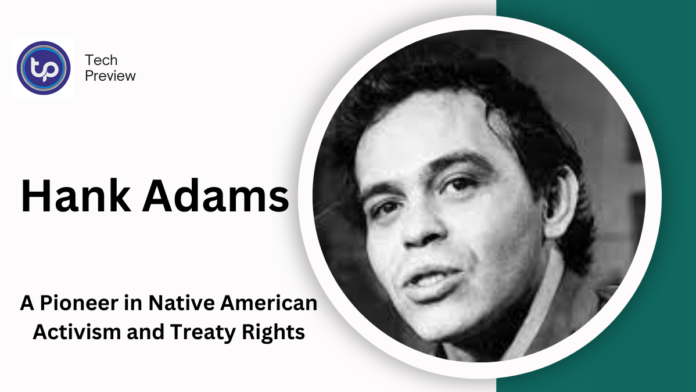Hank Adams, born on May 16, 1943, on the Fort Peck Indian Reservation in Montana, was a remarkable Native American rights activist whose lifelong dedication to justice made a lasting impact on the struggle for Native sovereignty.
As a strategist, negotiator, and tactician, Adams worked tirelessly to protect and assert the rights of Native American communities, particularly in the areas of fishing and hunting rights.
Through his leadership in key legal cases, protests, and negotiations, he became a central figure in the movement for Native American self-determination during the 1960s and 1970s.
Adams is perhaps best known for his instrumental role in the Boldt Decision of 1974, a landmark ruling that affirmed Native American fishing rights in Washington State.
He also played a pivotal part in various protests, including the Trail of Broken Treaties caravan and the Wounded Knee occupation, where his negotiation skills helped secure peaceful resolutions during tense standoffs.
Throughout his career, Hank Adams not only advocated for the rights of Native Americans but also worked to restore and preserve the cultural traditions and self-governance of tribal communities across the United States.
The Activist’s Early Life and Path to Advocacy
Hank Adams’ early life shaped his passion for Native American rights. Born into the Assiniboine tribe on the Fort Peck Indian Reservation, he witnessed firsthand the hardships faced by Native communities in the U.S.
After his family relocated to the Quinault Indian Reservation in Washington State, Adams grew up with a strong work ethic, often working on farms and fishing the nearby rivers.
MUST READ: Thanos Alligator Snapping Turtle: A Giant of Prehistoric Power and Modern Conservation
He excelled academically, becoming student-body president and taking part in sports, but his real calling emerged in the early 1960s when he became involved in efforts to address the challenges Native Americans were facing, particularly regarding treaty rights and social inequality.
In 1963, Adams joined the National Indian Youth Council (NIYC), where his advocacy for Native rights began to gain momentum. By the mid-1960s, he was organizing protests and campaigns against state efforts to curtail Native American fishing rights, especially in the Pacific Northwest.
His efforts helped galvanize the broader Native American rights movement, which sought to reaffirm Native sovereignty and challenge discriminatory policies.
ALSO READ : My Egocentric Boss Is Obsessed with Me : Exploring the Dark Side of Love
The Fight for Treaty Rights and Legal Victories
A key area of focus for Adams was the fight to protect Native American treaty rights, particularly the rights to hunt and fish on traditional lands. In the early 1970s, the state of Washington imposed restrictive fishing regulations that threatened the survival of Native fishing practices. Adams, alongside other activists like Billy Frank Jr., fought back through both protests and legal avenues.
One of the most significant victories in this battle was the Boldt Decision of 1974. Adams played a critical role in the legal case United States v. Washington, which centered on the interpretation of the 1855 treaties that guaranteed Native Americans in the Pacific Northwest the right to fish in their traditional territories.
The court ruled in favor of the tribes, affirming their rights to fish and co-manage salmon populations with the state of Washington. This decision marked a major milestone for Native American sovereignty and laid the foundation for future legal successes in the fight for Native rights.
Key Involvement in Native American Protests
Adams was also deeply involved in the protests and actions of the American Indian Movement (AIM), a group that sought to raise awareness about the systemic oppression of Native Americans. In 1972, Adams participated in the Trail of Broken Treaties caravan, which aimed to bring attention to the broken promises of the U.S. government regarding Native American treaties.
During the caravan’s stop in Washington, D.C., Adams drafted the Twenty Point Proposal, a set of demands for Native American sovereignty and the restoration of tribal rights. Although the proposal was not fully accepted, it marked an important step in the fight for Native self-determination.
Adams also played a crucial role in the Wounded Knee occupation of 1973, a standoff between AIM activists and U.S. government forces on the Pine Ridge Reservation in South Dakota. For 71 days, the occupiers fought for Native sovereignty and protested against the treatment of Native people. Adams acted as a key negotiator, helping to bring about a peaceful resolution to the conflict.
Conclusion: A Lasting Legacy
Hank Adams’ life was defined by his unwavering commitment to securing the rights of Native American tribes and their communities. Through his strategic thinking, determination, and leadership, he became a key figure in the Native rights movement, helping to change the trajectory of Native American advocacy in the 20th century.
His involvement in significant legal cases, his leadership in protests, and his tireless work to ensure that Native American voices were heard in the halls of government have left an indelible mark on the fight for justice.
Adams’ legacy continues to inspire Native American activists and advocates for indigenous rights today. His work ensured that the struggle for Native sovereignty would never be forgotten and that future generations would have the tools to continue pushing for equality and self-determination. Hank Adams proved that one person, armed with conviction and strategy, could change the course of history.
People May Ask
1. What were Hank Adams’ major contributions to Native American rights?
Hank Adams was instrumental in securing Native American fishing rights, particularly through his involvement in the Boldt Decision of 1974. He also played key roles in protests like the Trail of Broken Treaties and the Wounded Knee occupation, where he used his negotiation skills to help resolve tense situations peacefully.
2. How did Hank Adams influence the Boldt Decision?
Adams played a crucial role in the legal case United States v. Washington, which resulted in the Boldt Decision. He represented tribal fishermen in court, helping to secure the ruling that affirmed the right of Native Americans in Washington to fish on their traditional lands and manage fishing resources alongside the state.
3. What was the Trail of Broken Treaties?
The Trail of Broken Treaties was a caravan organized by the American Indian Movement (AIM) in 1972, where Native American activists traveled to Washington, D.C. to demand the federal government uphold its treaty promises. Adams was deeply involved in this protest and drafted the Twenty Point Proposal, a list of demands focused on Native American sovereignty and self-determination.
Click here to learn more.









